The Western Digital Blue (1TB) SSD Review: WD Returns to SSDs
by Billy Tallis on October 11, 2016 8:00 AM EST- Posted in
- SSDs
- Storage
- Western Digital
- SanDisk
Mixed Random Read/Write Performance
The mixed random I/O benchmark starts with a pure read test and gradually increases the proportion of writes, finishing with pure writes. The queue depth is 3 for the entire test and each subtest lasts for 3 minutes, for a total test duration of 18 minutes. As with the pure random write test, this test is restricted to a 16GB span of the drive, which is empty save for the 16GB test file.
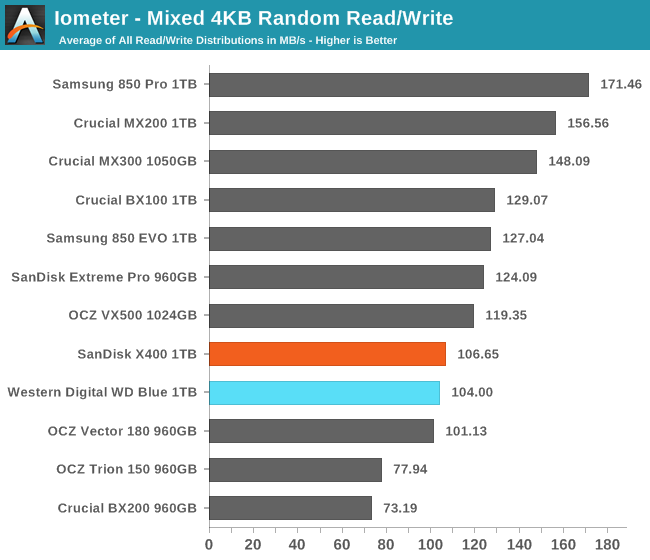
Like the SanDisk X400, the WD Blue performs better on the mixed random I/O test than competing planar TLC drives and about the same as the slowest MLC drives.
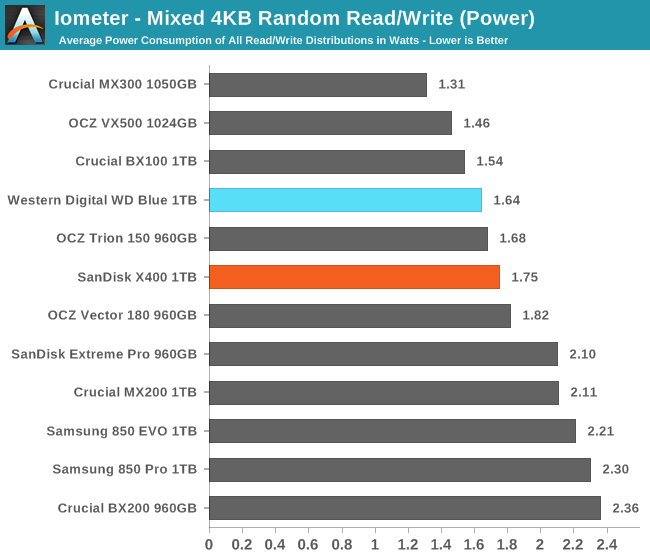
The WD Blue once again slightly raises the efficiency standards for planar TLC, but is still nowhere near as efficient as 3D TLC or MLC.
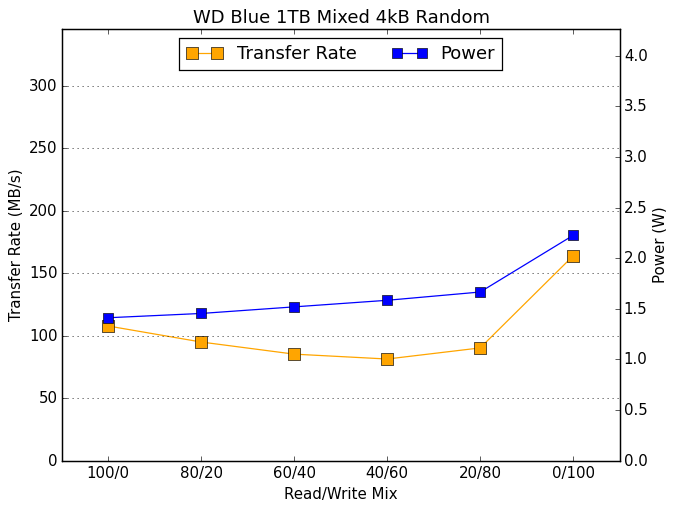 |
|||||||||
The WD Blue starts the mixed random I/O test with a pretty good random read speed, but performance declines as writes are added to the mix until near the end of the test, where the jump in the last segment of the test is not as large as what most drives experience.
Mixed Sequential Read/Write Performance
The mixed sequential access test covers the entire span of the drive and uses a queue depth of one. It starts with a pure read test and gradually increases the proportion of writes, finishing with pure writes. Each subtest lasts for 3 minutes, for a total test duration of 18 minutes. The drive is filled before the test starts.
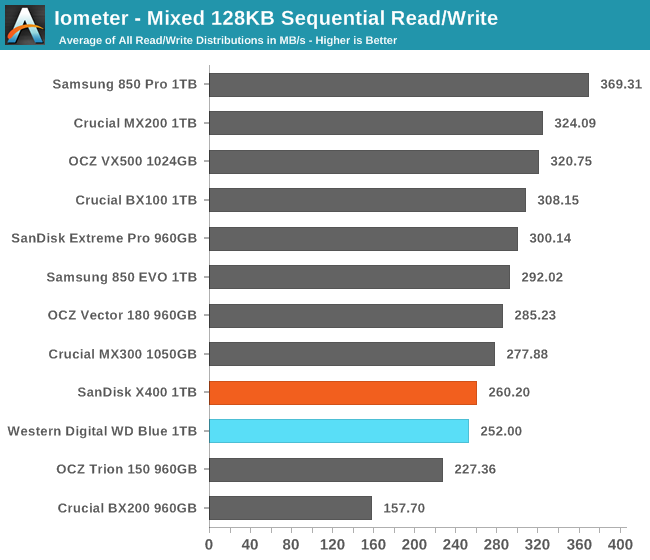
The WD Blue performs above average for a planar TLC SSD on the mixed sequential I/O test, but is not competitive with MLC or 3D TLC.
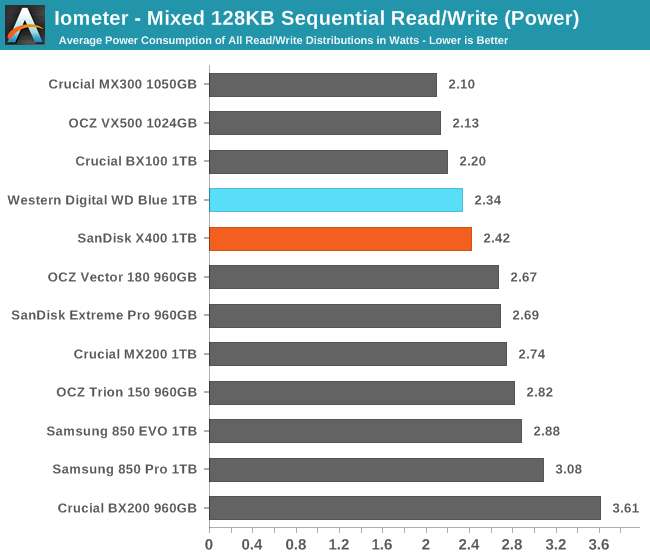
In absolute terms the WD Blue has pretty low power draw on this test, but the efficiency is not close to setting a record.
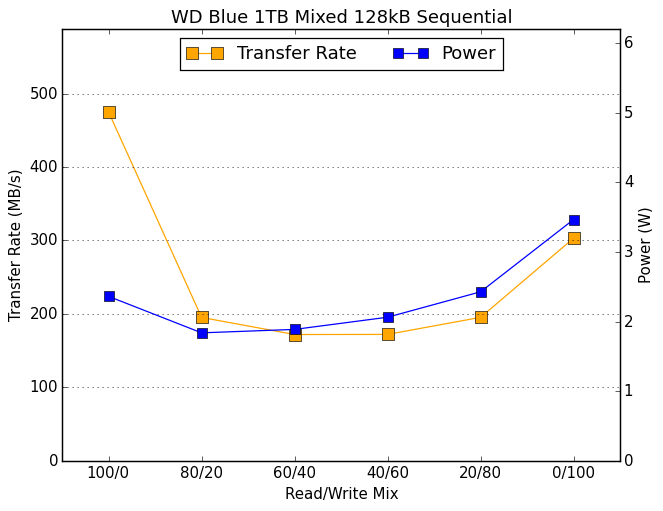 |
|||||||||
The WD Blue's U-shaped performance curve across this test is fairly typical, but the dropoff at the beginning is relatively steep and the minimum is a bit on the low side.










75 Comments
View All Comments
Decoherent - Friday, October 14, 2016 - link
There aren't a lot of reasons to use vendor-specific software (which often sucks) when you can use Macrium Reflect's free version, which is much more powerful. It's helped me sort out some other weird problems, too, such as fixing wrong UEFI entries that I couldn't figure out.jwcalla - Tuesday, October 11, 2016 - link
I don't think I would trust WD anything when it comes to storage.BrokenCrayons - Tuesday, October 11, 2016 - link
Why not? This is just a SanDisk drive with a few minor firmware tweaks. Besides that, WD was the industry leader before SSDs were a thing. Sure picking between Seagate, Quantum, Maxtor (omg that 4.3GB Bigfoot drive...how I missed your 3 months of dog slow performance before you started making the click o' death), and WD (I guess Toshiba and Hitachi too) was like picking between which rusty razor you'd prefer to slit your wrist with, but at least with WD drives you clould get a good gusher going before the blade broke.LordConrad - Tuesday, October 11, 2016 - link
I loved the Quantum Bigfoot, it was as great way to increase capacity for storage drives without having to wait for aerial density to increase.BrokenCrayons - Tuesday, October 11, 2016 - link
Oh the idea was sound. Going back to a 5.25 inch chassis to increase capacity seemed like a decent idea even though we'd long ago shifted to 3.5 inch drives. The problem with the Bigfoot was reliability. I had one I personally owned die on me and quite a few we sold to customers (12GB models) came back dead within less than 6 months. I remember all the hassles of getting RMAs done for those things. On the other hand, Quantum's 3.5 inch drives seemed fairly reliable. I wonder if there was a problem with heat expansion doing bad things to the read/write heads due to the larger platter size. It wasn't a problem with older 5.25 inch hard drives because they were usually full height and ran at a lower RPM than the Bigfoots.LordConrad - Tuesday, October 11, 2016 - link
I don't even remember what speed they ran at. Was it the full 5400rpm, or something slower like 5200 or 4900?BrokenCrayons - Wednesday, October 12, 2016 - link
I don't remember all the specs and had to look them up. The originals and the CY series ran at 3600 RPM and the TX, and TS series brought it up to 4000. If I recall correctly, when the Bigfoot was still in retail channels, a lot of 3.5 inch drives were ticking along at 3600 to 4200 RPM. 5400 RPM drives came along later and I don't know if Bigfoots were even in production when they were being sold as high performance storage solutions (well, non-SCSI drives anyhow...spindle speeds for SCSI devices were quite a bit higher).This is half from memory and the rest was from a couple of quick web searches so take all that with a grain of salt or two. I could be a bit off as it's been a long time.
mikato - Tuesday, October 11, 2016 - link
"I don't think I would trust anything when it comes to storage."That's better. Have backups that work.
But anyway, why all the dumping on WD? I don't think it is warranted.
barleyguy - Tuesday, October 11, 2016 - link
There have been many periods in the past where WD had very high failure rates. Because of that, many of us that have been around awhile have been bit in the butt by WD and don't trust them anymore. In the late 90s and early 2000s for instance, WD's failure rate was so high they had a wait queue and callback system set up for RMAs.That said, I think for last few years WD has been very good, so maybe it is unwarranted in the short term.
In particular I really like the WD Blue. They aren't fast, but they seem to be a very reliable drive, and throwing them in a RAID array with an SSD boot disk results in a pretty solid system.
Gigaplex - Tuesday, October 11, 2016 - link
Their main competitor, Seagate, has also had very high failure rates. Mikato was correct, don't trust any of them. There's no need to dump on WD more than the others.